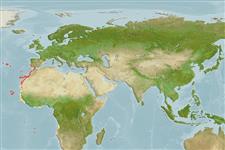>
Anguilliformes (Eels and morays) >
Muraenidae (Moray eels) > Muraeninae
Etymology: Enchelycore: Greek, enchelys, = eel + Greek, kore = pupil (Ref. 45335).
More on author: Lowe.
Environment: milieu / climate zone / depth range / distribution range
पारिस्थितिकी
समुद्री ड़िमरसल; गहराई सीमा 3 - 60 m (Ref. 58047). Subtropical; 40°N - 17°S, 32°W - 35°E
Eastern Atlantic: Azores, Madeira, Canary, Cape Verde, Ascension and St. Helena Islands including record from the Mediterranean coast of Israel (Ref. 3256), Greece (Ref. 43448) and Cyprus (Ref. 95695).
आकार / वज़न / Age
Maturity: Lm ? range ? - ? cm
Max length : 120 cm TL पुल्लिंग / अलिंग; (Ref. 5288)
Occasional among rocks and rubble to depths of at least 10 m. They stay concealed among rocks, waiting for prey to come along. Are active predators which feed on crustaceans and fish (Ref. 5377). Possibly consumed in subsistence fisheries (Ref. 3254).
Life cycle and mating behavior
परिपक्व अवधि | पुनरुत्पत्ति | मछलीऔ का अंडे देना | अंडे | Fecundity | लार्वा
Smith, D.G. and E.B. Böhlke, 1990. Muraenidae. p. 136-148. In J.C. Quero, J.C. Hureau, C. Karrer, A. Post and L. Saldanha (eds.) Check-list of the fishes of the eastern tropical Atlantic (CLOFETA). JNICT, Lisbon; SEI, Paris; and UNESCO, Paris. Vol. 1. (Ref. 4450)
IUCN Red List Status (Ref. 130435)
Threat to humans
Harmless
Human uses
मात्स्यिकी: निर्वाह मात्स्यिकी
अधिक जानकारी
आम नामउपशब्दचपायचयपरभक्षीईकोटोकसीकोलौजीपुनरुत्पत्तिपरिपक्व अवधिमछलीऔ का अंडे देनाSpawning aggregationFecundityअंडेEgg development
Age/Sizeबाढ़Length-weightLength-lengthLength-frequenciesमौरफोमैटरिक्सआकृति विज्ञानलार्वालारवल गतिकीभर्तीबहुतायतBRUVS
संदर्भजलीयकृषिजलीयकृषि रूपरेखाखींचआनुवंशिकीElectrophoresesहैरेटिबिलटीबीमारीप्रक्रमणNutrientsMass conversion
सहयोगीयोतस्वीरेStamps, Coins Misc.ध्वनिसिगुयटिरारफ्तारतैरने के प्रकारगिल क्षेत्रOtolithsदिमागदृष्टि
साधन
Special reports
Download XML
इंटरनेट स्रोत
Estimates based on models
Preferred temperature (Ref.
123201): 18.4 - 20.1, mean 19.8 °C (based on 14 cells).
Phylogenetic diversity index (Ref.
82804): PD
50 = 0.5002 [Uniqueness, from 0.5 = low to 2.0 = high].
Bayesian length-weight: a=0.00050 (0.00025 - 0.00101), b=3.26 (3.10 - 3.42), in cm total length, based on LWR estimates for this (Sub)family-body shape (Ref.
93245).
Trophic level (Ref.
69278): 4.0 ±0.67 se; based on food items.
लौटाव (Ref.
120179): बहुत नीचे, न्यूनतम जनसंख्या दुगनी समय अवलागत 14 महीने। (Preliminary K or Fecundity.).
Fishing Vulnerability (Ref.
59153): High to very high vulnerability (72 of 100).
Nutrients (Ref.
124155): Calcium = 43 [26, 85] mg/100g; Iron = 0.798 [0.453, 1.327] mg/100g; Protein = 18.7 [16.6, 21.2] %; Omega3 = 0.248 [0.111, 0.634] g/100g; Selenium = 35.8 [18.4, 77.2] μg/100g; VitaminA = 8.77 [2.53, 31.31] μg/100g; Zinc = 0.572 [0.422, 0.812] mg/100g (wet weight);
